This blog was written by Antero Garcia, chair of the working committee that produced the new “Guidelines for Dealing with Censorship of Instructional Materials.” Other committee members included Lisa Loomis of the Hartford Public Schools, Hartford, Connecticut, and Alan Teasley of Duke University, Durham, North Carolina.
Recently, I had the opportunity to revisit an NCTE position statement focused on censorship and online texts. Along with my committee co-members Lisa Loomis and Alan Teasley, we renamed the statement “Guidelines for Dealing with Censorship of Instructional Materials.”
First of all, I want to recognize that this statement was honed from the previous, powerful work of the NCTE Standing Committee Against Censorship. This group last revised this statement in October of 2004, almost a decade and a half ago. To put this into perspective, the original version of these guidelines described the role of online resources in a moment before YouTube, Facebook, Twitter, the Arab Spring, the Occupy movement, #BlackLivesMatter, and fake news. At the time, No Child Left Behind was a relatively new policy, Barack Obama was not yet a US senator, and the iPhone was still several years from being released. Arguably, it was a different world from the one that we teach and learn in today.
In the previous version of this statement, the guidelines were not for “Instructional Materials” broadly, as it is now labeled. Instead, the statement was titled “Guidelines for Dealing with Censorship of Nonprint and Multimedia Materials.” The shift in the title signals the biggest changes we’ve made and how the committee I was able to work with understands the challenges that have reshaped English teaching today. Though multimedia material may have felt like a novel but important addition in the classrooms of 2004, there is a fluidity of text, its consumption, and its production that feels even more seamless in 2018. In my opinion, every text is multimodal and the expectations against censorship and for meaningful recognition of the value of this work is required if teachers are looking at canonical literature, a political speech on YouTube, a hashtag of polyphonic conversation on Twitter, or a student-produced documentary made with smartphones and tablets readily available in nearly every classroom today. Instead of separating “nonprint” (and simultaneously, unnecessarily privileging “print” in the process), our committee decided that our guidelines should speak across the content decisions that teachers make every day.
But this wasn’t the only change we made.
The past several years have highlighted two other substantial ways that censorship can affect classroom communities and the decisions that English teachers make. As hinted above, the tools for students to make and publicly share their work are ever more ubiquitous today. As we consider the dangers of silencing youth voice, our guidelines specifically adapted to consider how censorship is about both consuming and producing in classrooms.
Related, recent global incidents of harassment, violence, and abusive trolling have demonstrated that historically marginalized communities—particularly youth of color and members of the LGBTQ community—are at the most risk when it comes to some kinds of online interactions. Censoring their voices is tied to power, and we attempted to articulate this and the guidelines around it.
Finally, while this position statement is a call to push against censorship, I also want to recognize that the sensitive materials that will be read and created in classrooms require precision, nuance, and care. Teachers must make careful decisions around both how and why particular texts should be brought in or omitted from instructional plans. These are decisions that require empathy with the needs of your students. Though these guidelines speak to the broad NCTE community—including parents and administrators—we hope they will help you with the powerful instructional work in your classrooms this year.
 Antero Garcia is an assistant professor in the Graduate School of Education at Stanford University. His research focuses on the literacy and civic possibilities of English education.
Antero Garcia is an assistant professor in the Graduate School of Education at Stanford University. His research focuses on the literacy and civic possibilities of English education.

